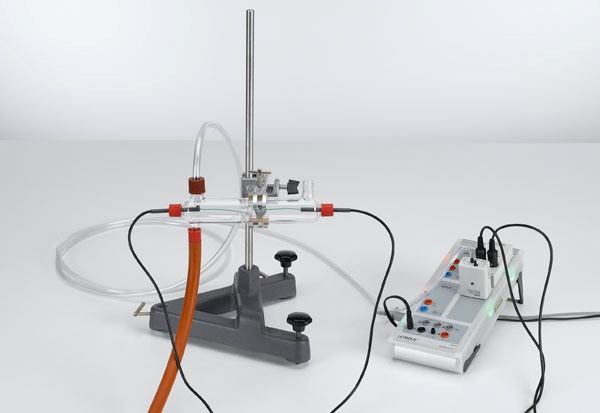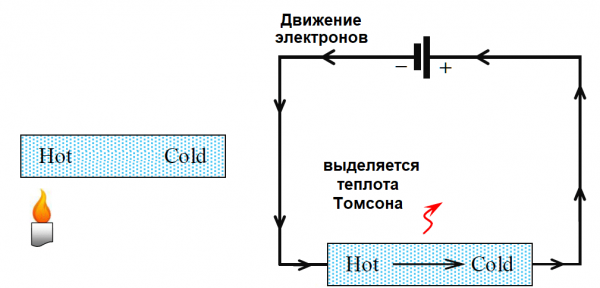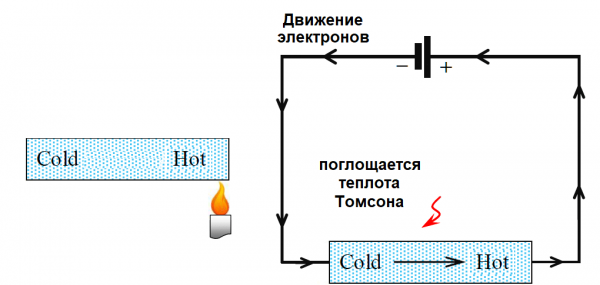Thomson effect — a thermoelectric phenomenon
When a direct electric current passes through a wire, that wire is heated according to with the Joule-Lenz law: the released thermal power per unit volume of the conductor is equal to the product of the current density and the strength of the electric field acting in the conductor.
This is because those that move in the wire under the action of an electric field free electrons, forming a current, collide with the nodes of the crystal lattice along the way and transfer part of their kinetic energy to them, as a result, the nodes of the crystal lattice begin to vibrate more strongly, that is, the temperature of the conductor rises throughout its volume.
The more electric field strength in a wire — the higher the speed of the free electrons have time to accelerate before they collide with the nodes of the crystal lattice, the more kinetic energy they have time to gain on the free path and the more momentum they transfer to the nodes of the crystal lattice at the moment on a collision course with them.It is obvious that the greater the electric field, the free electrons in the conductor are accelerated, the more heat is released in the volume of the conductor.

Now let us imagine that the wire on one side is heated. That is, one end has a temperature higher than the other end, while the other end has approximately the same temperature as the surrounding air. This means that in the heated part of the conductor the free electrons have higher speeds of thermal movement than in the other part.
If you leave the wire alone now, it will gradually cool down. Some of the heat will be transferred directly to the surrounding air, some of the heat will be transferred to the less heated side of the wire, and from it to the surrounding air.
In this case, the free electrons with higher rates of thermal movement will transfer the momentum to the free electrons in the less heated part of the conductor until the temperature in the entire volume of the conductor is equalized, that is, until the rates of thermal movement of the free electrons throughout the volume of the conductor is equalized.
Let's complicate the experiment. We connect the wire to a direct current source, preheating the side with a flame to which the negative terminal of the source will be connected. Under the influence of the electric field created by the source, the free electrons in the wire will begin to move from the negative terminal to the positive terminal.
In addition, the temperature difference created by preheating the wire will contribute to the movement of these electrons from minus to plus.
We can say that the electric field of the source helps to spread heat along the wire, but the free electrons moving from the hot end to the cold end are usually slowed down, which means that they transfer additional heat energy to the surrounding atoms.
That is, in the direction of the atoms surrounding the free electrons, additional heat is released relative to the Joule-Lenz heat.
Now heat one side of the wire again with a flame, but connect the current source with a positive lead to the heated side. On the side of the negative terminal, the free electrons in the conductor have lower speeds of thermal movement, but under the action of the electric field of the source they rush to the heated end.
The thermal motion of free electrons created by preheating the wire propagates to the motion of these electrons from minus to plus. Free electrons moving from the cold end to the hot end are generally accelerated by absorbing heat energy from the heated wire, meaning they absorb the heat energy of the atoms surrounding the free electrons.
This effect was found in 1856 British physicist William Thomsonwhich found that in a uniformly nonuniformly heated direct current conductor, in addition to the heat released in accordance with the Joule-Lenz law, additional heat will be released or absorbed in the volume of the conductor, depending on the direction of the current (third thermoelectric effect).

The amount of Thomson heat is proportional to the magnitude of the current, the duration of the current, and the temperature difference in the conductor.t — Thomson coefficient, which is expressed in volts per kelvin and has the same size as thermoelectromotive force.
Other thermoelectric effects: Seebeck and Peltier effect


